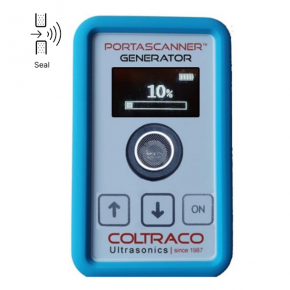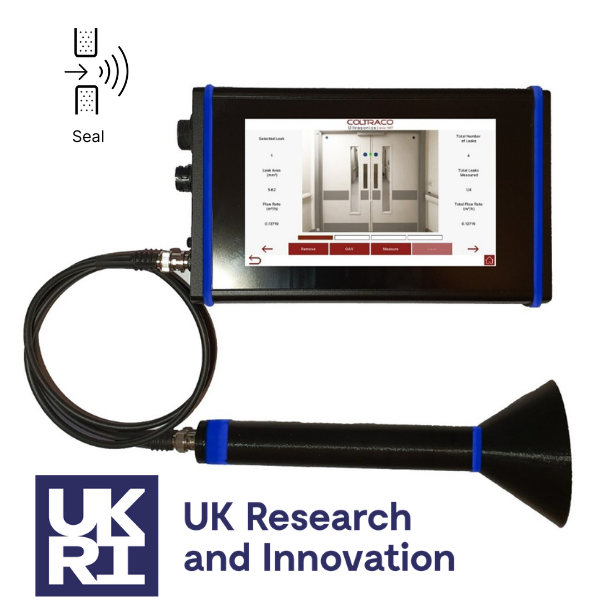
Evolve Buildings from being Passive Structures to Interactive and Reactive Systems
Bernard Hornung, Head of Operations, Built Environment, Coltraco Ultrasonics, talks about an innovative solution to help the building and facilities management sectors make steps to improve airtight testing.
“Today, and in fighting this awful virus, it has never been more pertinent to test room integrity, for airtightness. Buildings that are not airtight cannot be properly mechanically ventilated. Now is the time to build tight, ventilate right.
Until the outbreak of this global pandemic there was plenty of frustration around the slow pace of technology adoption within the built environment.
Whilst other industries had made good progress, teams of builders were struggling to meet minimum building performance standards. Inefficient processes left much room for improvement.
New homes often fail to meet low-energy targets, and to satisfy residents with fundamental issues such as ease of use, summer comfort and energy costs. There is far too little Building Performance Evaluation (BPE) happening routinely on projects to close the performance gap.
How COVID-19 changed our building sector
The pandemic can be credited with pushing the construction industry in the right direction. Many processes have changed and there is no need to go back to the way it was.
The technological advances that would have happened over the next few decades, have now been achieved, due to the pandemic’s dramatic acceleration of technology adoption.

Most buildings are tested for airtightness, air permeability, and air leaks with outdated and intrusive technology, making tests difficult, time consuming and expensive.
Yet it is critical to quickly locate and accurately quantify air leaks in rooms and buildings.
There is now a unique solution from Coltraco Ultrasonics who have brought testing for airtightness, and air permeability into the 21st Century. Air leaks with a diameter as small as 0.5mm can now be detected and quickly located with the Portascanner® AIRTIGHT 520.
Buildings, airtightness and ventilation
In March 2020, the world as we knew it fundamentally and suddenly changed, however, innovation continued to evolve and thrive. There was an urgent requirement within the NHS to prevent infection spread in hospitals and contain the virus by maintaining negatively pressurised ICU Wards and ensuring their airtightness.
UK Government put out a COVID-19 emergency response grant through InnovateUK for technology to help the NHS. In June 2020 Coltraco Ultrasonics was one of the winners.
The grant was for adapting their already award-winning watertight integrity technology into technology suitable for room airtight testing.
Like many businesses, Coltraco Ultrasonics was transformed by the pandemic. In just 8 months Coltraco Ultrasonics had successfully designed and manufactured 2 innovative solutions to help the NHS and healthcare settings with infection control and the building sector to ensure effective ventilation through airtightness.
Following from this need to contain the spread of airborne diseases, Coltraco Ultrasonics swiftly saw the demand for this leak detection technology to be re-designed for the built environment.
Portascanner® AIRTIGHT 520
Portascanner® AIRTIGHT 520 is a new solution to ensure that buildings are airtight so that people can be confident that they are returning to ‘safe buildings’ and ‘safe working’ by properly ventilating them. This is to ensure that all ventilation systems are operating effectively, and thereby enhance indoor air quality (IAQ) which has now become a poignant issue.
No alternative leak measuring technologies measure the leak size directly, but instead infer it from pressure differences of airflow measurements, which are assumed to be taken at constant temperature and pressure, something that in reality, is never the case.

This means that alternative technologies have inaccuracies that may be minimised, but not eliminated entirely, by highly skilled operators using manual calculators.
For the first time, with minimal training, the user can locate a leak, quantify the leak site, calculate the air flow rate through it, and generate an air permeability value for the room.
You can then take accurate remedial action where necessary, and have full confidence in both the airtightness of your room, and the effectiveness of your ventilation in circulating clean air.
Solving the problem of clean air
Human Resources and Facilities Management Teams are tasked with keeping buildings and spaces comfortable, sustainable, efficient, safe, healthy and well maintained, and this list keeps growing as buildings, including residential buildings are expected to deliver more.
More can include addressing the effects of Climate Change by making a building more energy efficient. More after this pandemic will include a critical appraisal of indoor air quality.
Seventy per cent of the world’s population spends an estimated 90% of its time indoors, and the World Health Organisation estimates that in 2020 there were more than 6 million premature deaths due to air pollution much of it attributed to poor IAQ.
Digitalisation has the power to evolve buildings from being fixed passive structures into highly interactive and richly informative systems.
Homes are becoming more autonomous, so that the mechanical components inside of the spaces created can ensure that occupants are safer, healthier and more comfortable.
Addressing air pollution
Air filtration has never been considered a hot topic, but reflecting on what we know now, perhaps it should have been. Air quality plays an important role in our physical and mental health, and with COVID-19 good air filtration could mean the difference between sick and healthy, and in some cases, life and death.
A fundamental requirement for energy efficient mechanical ventilation and for effective air filtration is achieving a minimum level of air tightness in buildings. Air pollution is an increasing concern, as is maintaining an adequate level of Oxygen within the built environment.
The air we breathe is made up of multiple gases, however for a human to function normally the air must contain enough oxygen. Under normal atmospheric pressure we normally inhale air that contains 20.9% oxygen; if this falls even by one or 2%, then functionality starts to become more laborious and the environment turns hypoxic, meaning that oxygen levels are low and could be harmful.
Humans, like fires, need to have a constant and assured level of oxygen, and as we consume oxygen, more must be delivered to us.
The link between pandemics and ventilation in buildings
The design choices being programmed into buildings right now will be with us for years to come. This is a good thing because of the increased emphasis being placed upon, ‘Build tight, ventilate right.’
COVID-19 will not be the last pandemic disease we will suffer, but our spaces will be better prepared for when the next one strikes. Frequent, regular and periodic testing for air tightness, air permeability, and quickly locating and quantifying air leaks in buildings, so that immediate remedial action may be taken, is now possible.
Indoor air quality is a key issue in building design for homes, offices, hospitals, schools and factories. Our living and workplaces, be they at our homes or elsewhere, are where we need to be safe and productive.
This pandemic has shown the true value of good ventilation systems in buildings. There is a newfound respect for a hitherto poorly understood area of building engineering services.
As we move on from a Government rescue plan to a Government recovery plan, an essential component of ‘Build Back Better’, should include frequent, regular, and periodic, mandatory testing for air tightness in the built environment. Thanks to Coltraco Ultrasonics and their Portascanner® AIRTIGHT 520 this is now a faster, better and cheaper process.
Latest news

30th April 2025
Digital Construction Week announces seminar programme for its landmark 10th edition
Digital Construction Week (DCW) returns to ExCeL London on 4 – 5 June 2025 with its most impactful programme yet. It brings together the best and brightest from across AECO, for two days of practical learning and idea sharing.
Posted in Articles, Building Industry Events, Building Industry News, Building Products & Structures, Building Services, Building Systems, Exhibitions and Conferences, Information Technology, news, Restoration & Refurbishment, Retrofit & Renovation, Seminars
29th April 2025
Senior pledges to ‘bee’ part of the solution with new biodiversity initiative
Senior Architectural Systems has installed its first on-site beehive, marking another step forward in its commitment to sustainability and biodiversity.
Posted in Articles, Building Industry News, Building Products & Structures, Building Services, Curtain Walling, Doors, Glass, Glazing, Innovations & New Products, news, Restoration & Refurbishment, Retrofit & Renovation, Sustainability & Energy Efficiency, Walls, Windows
29th April 2025
West Fraser range delivering key benefits for South-East carpentry company
An experienced carpenter and building site manager who has recently set up his own company is using high performance panel products from the West Fraser range.
Posted in Articles, Building Industry News, Building Products & Structures, Building Systems, Case Studies, Garden, Restoration & Refurbishment, Retrofit & Renovation, Sustainability & Energy Efficiency, Timber Buildings and Timber Products
29th April 2025
CPD Courses Available Online From Ecological Building Systems
Ecological Building Systems, a leading supplier of natural building products for sustainable construction, has revealed its comprehensive CPD programme for the year ahead.
Posted in Articles, Building Industry Events, Building Industry News, Building Products & Structures, Building Services, Continuing Professional Development (CPD's), Information Technology, Innovations & New Products, Insulation, Restoration & Refurbishment, Retrofit & Renovation, Seminars, Sustainability & Energy Efficiency, Training, Walls, Waste Management & Recycling
 Sign up:
Sign up: